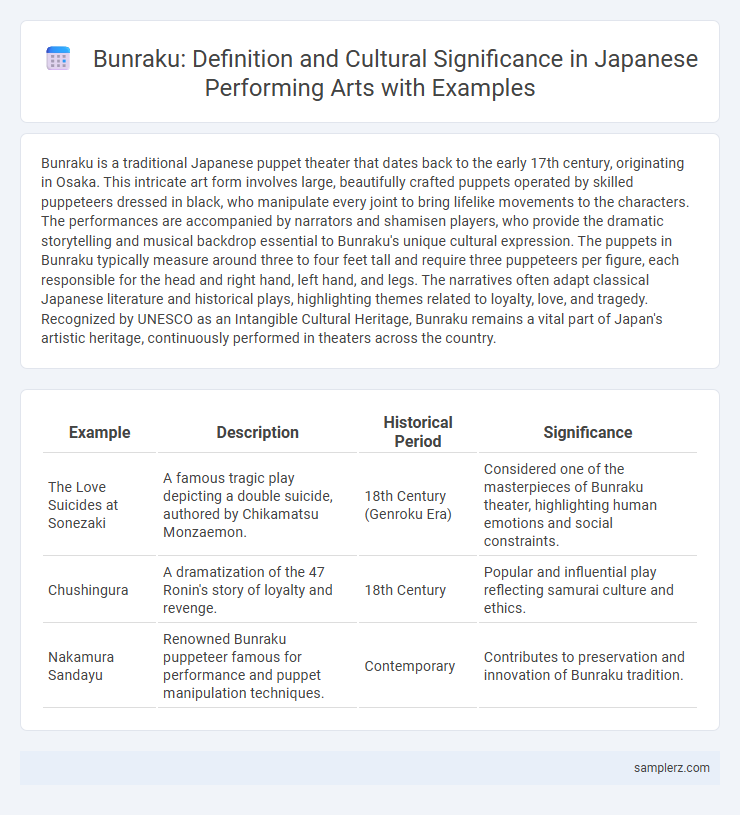Bunraku is a traditional Japanese puppet theater that dates back to the early 17th century, originating in Osaka. This intricate art form involves large, beautifully crafted puppets operated by skilled puppeteers dressed in black, who manipulate every joint to bring lifelike movements to the characters. The performances are accompanied by narrators and shamisen players, who provide the dramatic storytelling and musical backdrop essential to Bunraku's unique cultural expression. The puppets in Bunraku typically measure around three to four feet tall and require three puppeteers per figure, each responsible for the head and right hand, left hand, and legs. The narratives often adapt classical Japanese literature and historical plays, highlighting themes related to loyalty, love, and tragedy. Recognized by UNESCO as an Intangible Cultural Heritage, Bunraku remains a vital part of Japan's artistic heritage, continuously performed in theaters across the country.
Table of Comparison
| Example | Description | Historical Period | Significance |
|---|---|---|---|
| The Love Suicides at Sonezaki | A famous tragic play depicting a double suicide, authored by Chikamatsu Monzaemon. | 18th Century (Genroku Era) | Considered one of the masterpieces of Bunraku theater, highlighting human emotions and social constraints. |
| Chushingura | A dramatization of the 47 Ronin's story of loyalty and revenge. | 18th Century | Popular and influential play reflecting samurai culture and ethics. |
| Nakamura Sandayu | Renowned Bunraku puppeteer famous for performance and puppet manipulation techniques. | Contemporary | Contributes to preservation and innovation of Bunraku tradition. |
Origins and History of Bunraku in Japan
Bunraku, a traditional Japanese puppet theater, originated in the early 17th century during the Edo period. It evolved from earlier puppet performances and storytelling techniques, combining chanting narration, shamisen music, and intricate puppetry to create a unique theatrical experience. The art form reached its peak under playwright Chikamatsu Monzaemon, whose dramatic scripts solidified Bunraku's cultural significance in Japan.
Key Elements of Bunraku Performance
Bunraku, a traditional Japanese puppet theater, features three key elements: intricate puppetry manipulation, narrative chanting, and shamisen musical accompaniment. Skilled puppeteers operate large, detailed puppets with precise movements, while the tayu provides vocal narration and dialogue, supported by the shamisen's emotive strings. This harmonious integration of puppetry, storytelling, and music creates Bunraku's unique, immersive cultural experience.
Structure of a Traditional Bunraku Play
A traditional Bunraku play features a multi-act structure combining narrative chanting (joruri), shamisen music, and intricate puppet manipulation by skilled puppeteers. Each act often explores themes of human emotion, social conflict, or historical events, with distinct scenes portraying detailed character interactions. The precision of synchronized voice, music, and movement creates an immersive storytelling experience unique to this centuries-old Japanese art form.
Notable Bunraku Plays and Their Significance
Notable Bunraku plays such as "The Love Suicides at Sonezaki" by Chikamatsu Monzaemon reveal deep themes of loyalty and tragedy, highlighting the emotional intensity unique to this art form. "Sugawara and the Secrets of Calligraphy" emphasizes historical reverence and moral values, demonstrating Bunraku's role in preserving Japanese cultural heritage. These plays continue to influence contemporary theater and exemplify Bunraku's significance as a vessel for storytelling and cultural expression.
Famous Bunraku Playwrights and Works
Chikamatsu Monzaemon is renowned as the foremost Bunraku playwright, famous for works such as "The Love Suicides at Sonezaki," which poignantly explores themes of love and tragedy. Namiki Sosuke contributed significantly with plays like "Keisei Asoyama Sakura," highlighting complex human emotions and social conflicts. These playwrights' masterpieces remain central to Bunraku's cultural heritage, showcasing intricate puppet manipulation combined with profound storytelling.
Symbolism and Themes in Bunraku Theater
Bunraku theater embodies profound symbolism through its intricately crafted puppets that represent human emotions and societal roles, emphasizing themes of loyalty, honor, and tragedy. The use of puppeteers in visible black attire symbolizes the invisible forces shaping human destiny, while the narratives often explore conflicts between personal desire and social obligation. These elements collectively highlight Bunraku's role as a cultural vessel reflecting Edo-period values and universal human experiences.
The Role of Puppeteers in Bunraku
Puppeteers in Bunraku play a crucial role, skillfully manipulating intricate wooden dolls to convey profound emotion and narrative depth. Each puppet requires a team of three specialists, with the chief puppeteer controlling the head and right hand, ensuring lifelike movements that captivate audiences. Their precise coordination and mastery of traditional techniques embody centuries of Japanese cultural heritage, making the puppeteers indispensable to Bunraku theater.
Musical Accompaniment in Bunraku: Shamisen and Narrators
Bunraku, a traditional Japanese puppet theater, features intricate musical accompaniment primarily through the shamisen, a three-stringed instrument integral to setting mood and pacing. Skilled narrators, called tayu, deliver multiple character voices and narrative exposition, blending seamlessly with the shamisen's rhythms to enhance the storytelling. This collaboration between shamisen players and tayu creates a dynamic auditory experience essential to Bunraku's emotional depth and cultural significance.
Bunraku Today: Contemporary Examples and Revivals
Bunraku today thrives through contemporary performances that blend traditional puppetry with modern themes, attracting diverse audiences in Japan and worldwide. Revivals in urban theaters such as the National Bunraku Theatre in Osaka showcase innovative adaptations while preserving intricate puppetry techniques. Educational programs and international collaborations further sustain Bunraku's cultural relevance and global appreciation.
Cultural Impact and Preservation of Bunraku in Modern Japan
Bunraku, Japan's traditional puppet theater, profoundly influences cultural heritage by preserving Edo-period storytelling and artistry. This intricate performance combining puppetry, narrative chanting, and shamisen music sustains historical craftsmanship and promotes cultural identity. Efforts by cultural institutions and government support ensure Bunraku remains vibrant in modern Japan, attracting both domestic audiences and international scholars.

example of bunraku in Japanese Infographic
 samplerz.com
samplerz.com